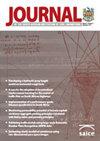Geotechnical properties of Cape Flats sands
IF 0.6
4区 工程技术
Q4 ENGINEERING, CIVIL
Journal of the South African Institution of Civil Engineering
Pub Date : 2022-07-05
DOI:10.17159/2309-8775/2022/v64no2a2
引用次数: 0
Abstract
The sand-covered coastal plain connecting the Cape Peninsula mountain chain to the southwestern Cape mainland is known as the Cape Flats. The whitish windblown sands covering this area of approximately 460 km2, referred to as the Quaternary sands of the Cape Flats, provide founding for the rapid and ongoing development in the area. A knowledge of the geotechnical properties and engineering behaviour of these sands is essential for design of suitable foundations for proposed structures and earthworks associated with such developments. By combining, analysing and interpreting the wealth of existing and available geotechnical information from previous and new soil investigations undertaken in the area, the Quaternary-aged sands of the Witzand, Springfontyn and Langebaan Formations from the Cape Flats were characterised in terms of their physical properties and engineering behaviour. The sands from the study area were classified based on their grading, Atterberg limits, maximum dry density and optimum moisture content, minimum dry density, California Bearing Ratio (CBR), erodibility and corrosivity, and characterised in terms of their compressibility, shear strength, permeability, volumetric behaviour during shear including liquefaction potential, in-situ density and moisture content and specific gravity. The Cape Flats sands were found to be highly variable (with both inter- and intra-formation variation), with a wide range in many material properties, principally a function of soil texture, gradation and degree of cementation. The findings of this research may be used to form initial appreciation of the likely properties of the material and potential problem areas.Cape Flats砂的岩土工程特性
连接开普半岛山脉和西南开普大陆的沙质海岸平原被称为开普平原。覆盖该地区约460平方公里的白色风积沙,被称为海角平原的第四纪沙,为该地区的快速和持续发展奠定了基础。了解这些沙子的岩土特性和工程性能对于设计与此类开发相关的拟建结构和土方工程的合适基础至关重要。通过结合、分析和解释该地区先前和新进行的土壤调查中丰富的现有和可用岩土工程信息,对开普平原Witzand、Springfontyn和Langebaan地层的第四纪老化砂的物理特性和工程性能进行了表征。根据级配、阿太堡界限、最大干密度和最佳含水量、最小干密度、加州承载比(CBR)、可蚀性和腐蚀性对研究区域的砂进行分类,并根据其压缩性、抗剪强度、渗透性、剪切过程中的体积行为(包括液化潜力)进行表征,原位密度、含水量和比重。Cape Flats砂的变化很大(地层间和地层内都有变化),许多材料性质变化很大,主要是土壤质地、级配和胶结程度的函数。这项研究的发现可以用来初步评估材料的可能性质和潜在的问题领域。
本文章由计算机程序翻译,如有差异,请以英文原文为准。
求助全文
约1分钟内获得全文
求助全文
来源期刊
CiteScore
0.70
自引率
25.00%
发文量
19
审稿时长
>12 weeks
期刊介绍:
The Journal of the South African Institution of Civil Engineering publishes peer reviewed papers on all aspects of Civil Engineering relevant to Africa. It is an open access, ISI accredited journal, providing authoritative information not only on current developments, but also – through its back issues – giving access to data on established practices and the construction of existing infrastructure. It is published quarterly and is controlled by a Journal Editorial Panel.
The forerunner of the South African Institution of Civil Engineering was established in 1903 as a learned society aiming to develop technology and to share knowledge for the development of the day. The minutes of the proceedings of the then Cape Society of Civil Engineers mainly contained technical papers presented at the Society''s meetings. Since then, and throughout its long history, during which time it has undergone several name changes, the organisation has continued to publish technical papers in its monthly publication (magazine), until 1993 when it created a separate journal for the publication of technical papers.

 求助内容:
求助内容: 应助结果提醒方式:
应助结果提醒方式:


